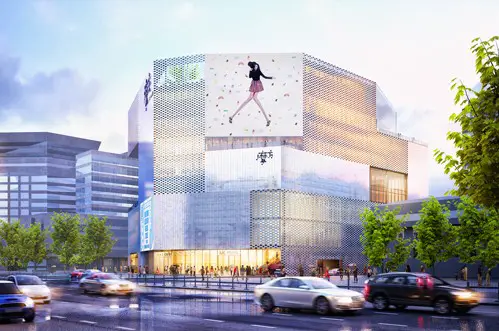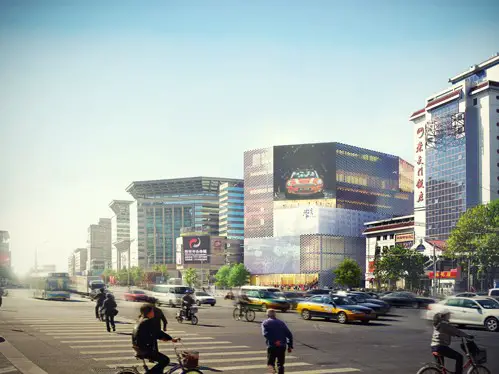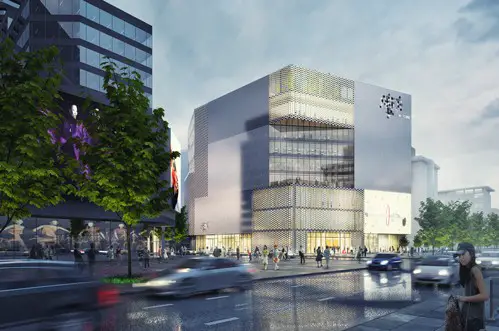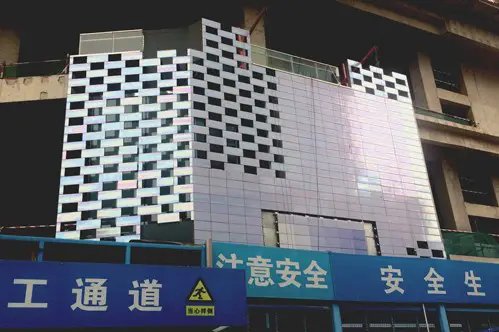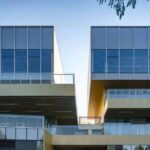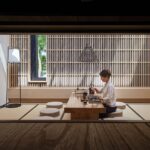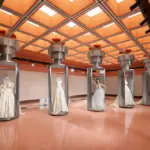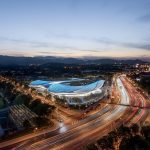M-Cube Shopping Centre, Beijing Mall, China Shop, Chinese Architecture, Architect, Images
M-Cube shopping centre in Beijing
Chinese Retail Building, Chongwenmen – design by MVRDV
22 Feb 2016
M-Cube Shopping Centre
Design: MVRDV
Location: Chongwenmen, Beijing, China
M-Cube
Exterior construction has almost been completed on MVRDV’s shopping centre, the Chongwenmen M-Cube which sits in the heart of Beijing. The project, designed with KWG Property, a Guangzhou based real estate corporation, consists of a singular building that combines day-time shopping and vibrant night-life, acting as a major hub in the central district of Chongwenmen. MVRDV’s primary innovation in the construction of the project was in developing a pearlescent façade that not only will add vibrancy to the street, but uses newly adapted materials as part of MVRDV’s push for consistently progressive architectural technologies. Construction of the entire project is due to be completed in summer of this year.
Located in the heart of Beijing, the 44.000 sqm Chongwenmen M -cube aims to become a centralised hub for retail, cuisine and leisure on what is known as one of the City’s busiest areas. The plot sits next to the historic hutongs and Temple of Heaven, as well as new retail centres and the Beijing Railway Station, proving to have potential to be a key location for tourists and Beijing shoppers.
MVRDV was faced with the challenge of maximising the commercial value of the comparatively small plot. The basic volume was first extruded to the maximum height limit and then cut away to establish visual and symbolic connections with various key parts of the city: The Forbidden City, from the top levels; Beijing Railway Station, from the middle terrace; and the main street and metro station at ground level. By doing so, MVRDV vastly increased the visible façade of the building, largely used for advertisement space, thus hugely improving commercial exposure.
The programme of the building centres itself around a generous atrium. The lower levels of the building will be primarily retail, whereas the upper floors will contain restaurants, bars and an elevated lobby connected directly to the street below via exterior escalators ; which allows for after shop-hours access to the upper floors. Visitors will also be able to access the building via an underground walkway which leads directly from the metro station. The ground floor opens up the street, re-animating the ground level and giving back a human scale that been somewhat lost because of the busy road and surrounding tall buildings. At the same time, the rooftop garden and terraces provide quiet refuge from the busy cityscape below.
Having been given the opportunity to design in such a prominent location MVRDV have taken on the challenge with the aim to create a contextual and responsive design that looks to revitalise the street and realise its potential of being a centre for cosmopolitan activity.
“The façade design balances between the desire of the client to create a striking building and the restrictive architectural conditions in that part of Beijing, demanding greys and beiges.” says MVRDV co-founder Jacob van Rijs, “Depending on the viewpoint both parties can be satisfied as the façade material appears differently when looking at different angles, it varies from subtle grey to all colours of the rainbow.”
For the Chongwenmen M-Cube MVRDV developed, with manufacturers NBK and HDTC, bespoke pearlescent ceramic tiles for the façade which keep the building in a constant state of visual animation. Each unique, hand glazed, tile radiates a whole spectrum of colours which fluctuate depending on where and when they´re viewed. As a result, the façade reveals new patterns and colours as lighting conditions change. What the tiles give the building is a sense of craft and human character, a welcome contrast to the standardised identical aluminium panels which clad the vast majority of the surrounding buildings.
The newly adapted tile follows MVRDV’s drive for innovation in architecture and material development. Past experiences in this include Gyre, a retail centre in Tokyo, which was clad in a specially developed façade tile, and Parkrand, a housing complex in Amsterdam that used a new method of glazing for the bricks.
The development of the façade system and layout took over a year in development and the processes ranged from exploring orientation, to tile glazing choices. Each façade is positioned in such a way as to increase visual interactions between the building and its context, whether it be through enhancing views from the building, or exposing the LED advertisement panels to the street below. The panelling itself opens up or closes off based on the privacy needs of the interior programme.
MVRDV won the competition to design the Chongwenmen M-Cube in February 2012 and have since been working as a team alongside: façade consultants, Meinhardt Façade Technology; contractor, Gartner Permasteelisa Group; tile manufacturers, NBK and HDTC; co-architect Xinjiyuan and client KWG.
M-Cube Shopping Centre in Beijing images / information from MVRDV
Location:Chongwenmen, Beijing, China
Beijing Architecture Walking Tours
Recent Beijing Architecture
Beijing CBD Eastern Expansion
SOM, architects
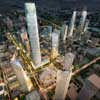
picture : SOM
Beijing CBD
Z15 Tower – tallest building in Beijing
TFP Farrells, BIAD, ARUP and MVA
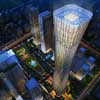
picture from architect
Z15 Tower
Beijing Architecture – Major Designs
Central Chinese Television Tower
Rem Koolhaas Architects / OMA
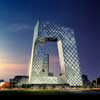
image from architect
CCTV Beijing
Capital Airport
Foster + Partners
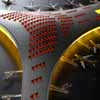
image : Nigel Young, from Foster + Partners
Beijing Airport Building
Comments / photos for the M-Cube Shopping Centre in Beijing page welcome
M-Cube Shopping Centre in Beijing – page
Website: MVRDV

